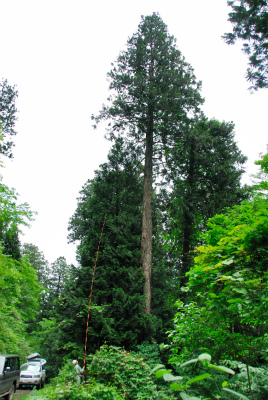Home > About us
Update:March 27, 2018
Main content starts here.
About us
Development of new forest tree varieties
Research on developing new forest tree varieties conducive to turning forestry into a growth industry
1.Development of second-generation Japanese cedar and larch
To select plus trees, the Tohoku Breeding Region focuses on the selection of coniferous trees to be used in afforestation. As an example, Table 1 shows first generation plus trees of Japanese cedar, cypress, red pine, black pine and larch trees that have been selected. These first-generation plus trees are studied from the standpoint of whether they possess the genetic characteristics suitable for the forest industry with respect to growth and quality. Based on the accumulation of data, the Tohoku Tree Breeding Office has been working towards the development of superior varieties.
The Tohoku TBO has been working towards the creation of the next generation plus trees. We have tree varieties created via cross-breeding of cedar plus trees. In addition, we have selected products of natural cross-breeding between first-generation Japanese cedar and larch plus trees at the seed orchard; second-generation plus trees called as “Elite Trees” would exhibit growth characteristics that greatly exceed the first-generation superior mating trees. Presently, we are developing third-generation plus trees.
In recent years, there has been greater attention paid to the importance of preserving forest trees in Japan in light of their ability to absorb carbon dioxide. Under these circumstances, it is necessary to produce seedlings with superior growth characteristics compared with those currently used for reforestation. To produce seeds with superior characteristics, we have been selecting “Specified Mother Trees” (Elite Trees) to be used as mother trees in the seed orchard.
Table 1. First-generation plus trees selected in the Tohoku Regional Breeding Region (number)
| Cedar | Cypress | Red Pine | Black Pine | Larch | Others | Total |
|---|---|---|---|---|---|---|
| 714 | 15 | 201 | 60 | 28 | 162 | 1180 |


Second-generation cedar and larch trees
2. Development of cedar varieties resistant to damage from snow
The Tohoku region, facing the Sea of Japan, is a snowy area with artificial cedar forests. The trunks of cedar trees experience tremendous pressure as snow falls in the upper slope. Pressure from the snow reduces the usefulness of these trees as it can lead to curvature at the base. Reduced commercial yield from snow damage is a major problem. To address this issue, the Tohoku RBO has selected cedar trees with minimal curvature from snow pressure from the artificial forests. Trees showing minimal curvature have been selected for comparison with other similar trees planted in a certified evaluation forest. Based on these studies, superior cedar varieties with resistance to snow pressure have been developed.
The Tohoku RBO has been working on developing next-generation of cedar varieties that are more resistant to snow pressure. By comparing growth characteristics of cedar varieties produced from cross-breeding of cedars showing resistance to snow damage and cedar generated from natural cross-breeding at a seed orchard showing resistance, second-generation snow-resistant cedar varieties have been produced. Efforts are underway to produce third-generation cedar varieties.

Dewanoyuki 1, Dewanoyuki 2 and curvature at the base of a tree
Development of new varieties conducive to land and environmental preservation
Development of tolerant varieties against pinewilt nematode
In the Tohoku region, red and black pines infected with pinewilt nematode wither and die. Damage caused by pine wilt disease is expanding. In a joint effort with other Tohoku regional research institutes, the Tohoku RBO has been developing red and black pines more resistant to infection with the pinewilt nematode.
To help in re-building everyday life and farming along the Pacific coast for those who suffered in the Great East Japan Earthquake, the focus has been in planting of black pine trees which have superior resistance to salt in the soil. It is necessary to restore forests along the coast that act as a barrier to tide, wind, and blowing sand. As damage caused by pinewood wilt is expanding, planting black pine trees with resistance to infection is highly desirable. However, the distribution of black pine seedlings with increased resistance to infection has been lagging in the Tohoku region. For this reason, the Tohoku RBO has received support from the science and technology research promotion program for agriculture, forestry, fisheries and food industries. Addressing this challenge is a joint public and private cooperative project.
Specifically, in response to the need for black pine varieties with increased resistance to salinity in the Tohoku region, seed production in the seed orchard has increased two to three-fold. Using plant-adventitious buds induced from cutting and immature seeds, clone seedlings were propagated on a massive scale. Resistant black pine seeds and seedlings produced in areas with warm local conditions served complementary roles. The use of these products has resulted in a stable system of distributing resistant clone seedlings for the purpose of restoring coastal forest barriers in areas affected by the great earthquake. It is expected that this system will be adopted on a widespread scale, leading to the restoration of coastal forests with black pine trees resistant to pine wilt disease.

Pine trees died due to pinewilt
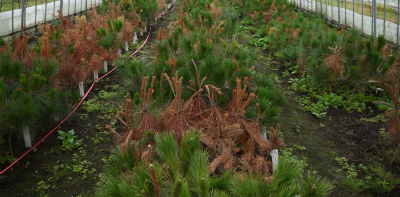
Status of inoculated seedlings inside a greenhouse
Propagation of foundation stock distributed to prefectures
Propagation and distribution of foundation stock
The mission of the Tohoku RBO is to meet the needs of prefectures in the region for plus trees, trees resistant to diseases, insects and weather damage as well as tree breeding materials (foundation stock). To that end, we have increased the supply of cuttings and grafted trees and distributed seedlings and scions. Distributed foundation stocks have been made available for the development of tree seed orchards or the improvement of existing seed orchards in the prefectures. Seeds and scions produced by prefectures in seed orchards and scion gardens have been made available to the seedling producers for distribution as breeding seedlings to entities involved in reforestation within the Tohoku Tree Breeding zone.
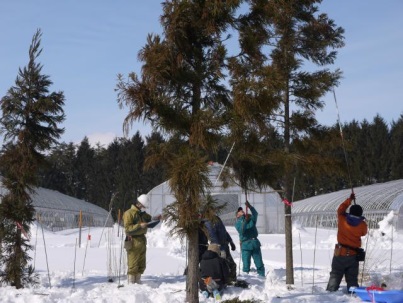
Collection of scions
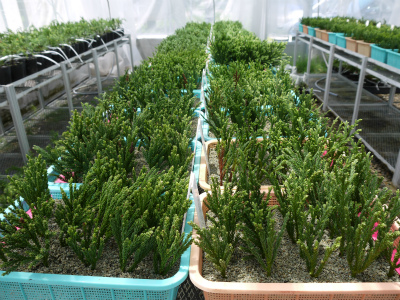
Cedar trees by cutting
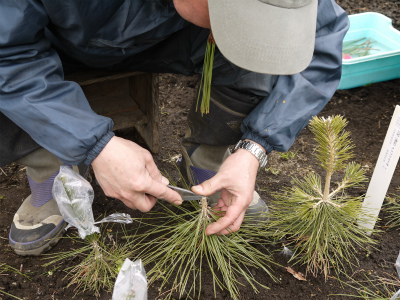
Red pine trees by grafting
Collection and conservation of tree genetic resources
- Collection and conservation of tree genetic resources
- To collect and conserve tree genetic resources and breeding materials, the Tohoku RBO is involved in the collection and conservation of breeding materials for cedar and other trees with high utility potential. The office also protects endangered or nationally protected species on the verge of disappearing by using a gene bank it operates. The accumulated genetic and breeding materials are used for varietal development. To ensure that the stored genetic material will be useful for future requirements, genetic characteristics are periodically examined.
|
|  Collection of Aoyajiro (Cryptomeria japonica) | 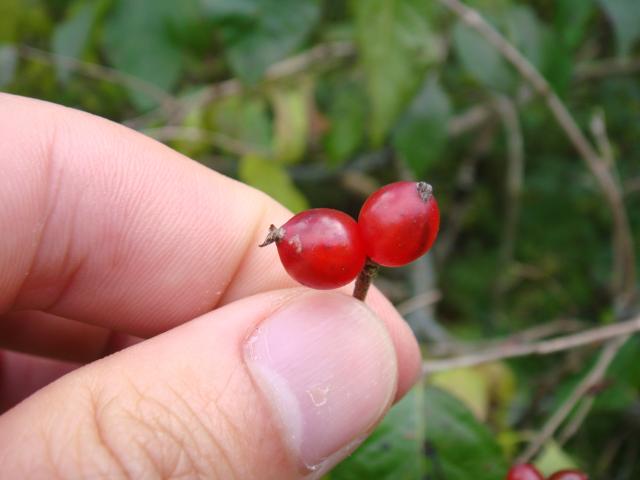 Collection of Amur honeysuckle (Lonicera maackii) |
- Emergency call for tree Gene bank
The Tohoku RBO is engaged in providing free services in helping preserve weakened, withered, or collapsing national treasure trees, as well as giant, famous and sacred trees for future generations. Upon requests from owners, we will use appropriate methods such as cutting or grafting to create clone seedlings with identical genetic characteristics as originals and return them to their original habitats. In general, replacement trees will be returned within two to three years. Services provided by the gene bank are applicable to those trees that meet the following criteria:
- Those determined by the forest tree breeding center to justify preservation as genetic materials.
- Trees that are natural treasures, giant, famous, and sacred or giant trees selected from the top 100 forests.
- Those judged to be weakened by advanced age and other factors as well as those that needs immediate replacements (those that are not compatible with cutting or grafting due to species or age will be excluded)
Example 1
Zenmyouan no Matsu (Pinus densiflora)
Located in Yokote City, Akita Prefecture. The tree standed 18 m high with a stem girth of 3.4 m and was estimated to be 800 years old. Strong winds in 2012 caused the main stem of the tree to split. As no repair was undertaken, the tree was fallen down as a safety measure to prevent a collapse. A request was received from Yokote City for a replacement. Using clone seedlings from 2010 stored at the Tohoku RBO, grafted seedlings were propagated in 2016. In May 2017, three clone seedlings were returned to the monastery and planted near the original mother tree.
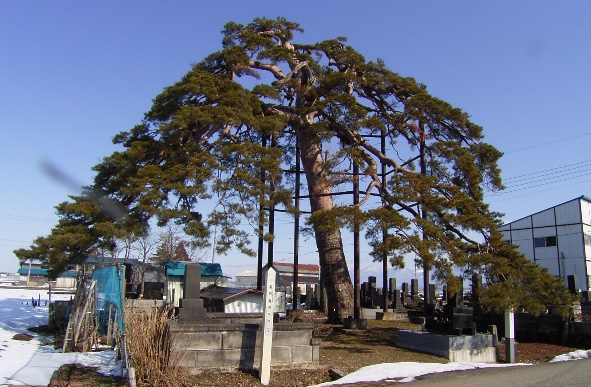
Zenmyouan no Matsu before it was cut
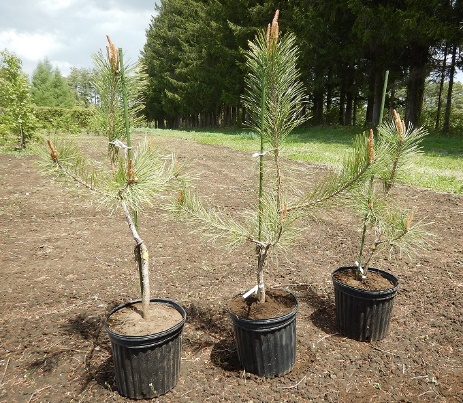
Example 2
Ichirizuka no Saikachi (Gleditsia japonica)
This tree is located in the city of Daisen, Akita prefecture. Its age is estimated to be 400 years with a height of 20 m and a stem girth of about 4 m. As a result of damage sustained from lightning and an ensuing fire, two-thirds of the main stem became hollow. The tree was weakened after it was cut about 5 m from the ground. As citizens wanted to preserve genetic materials for future restoration, we received a request for assistance. In 2015, a grafted tree was successfully grown and returned to its original location in June 2017 and planted next to the mother tree.
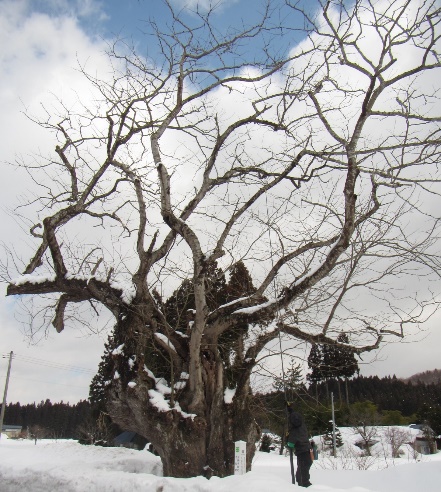
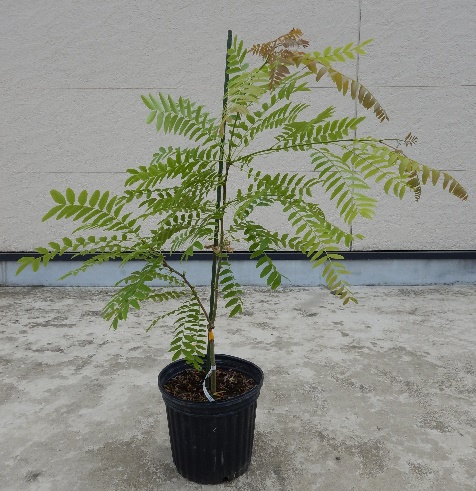
Ichirizuka no Saikachi
(Gleditsia japonica)
Copyright © Forest Research and Management Organization. All rights reserved.

